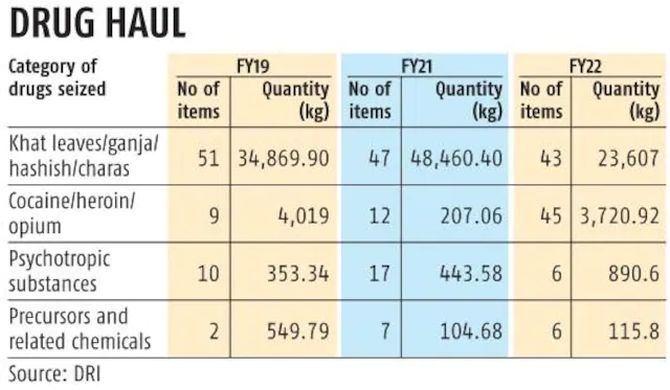Officials were surprised at how quickly smugglers appraised the Covid situation to recruit jobless migrant workers to ship gold.

A 'lot of' out-of-job Indian migrants to Gulf countries have been used by smugglers to ship gold into India, says areport titled Smuggling in India released by the Directorate of Revenue Intelligence (DRI) recently.
But while gold smuggling gets a lot of attention, officials said they were more concerned with the clear rise in smuggling of narcotics, as the data shows (see table).
There has been a spurt in the quantity of cocaine, heroin, opium and more processed psychotropic substances like fentanyl that were seized, indicating increased traffic in these items.
The menace prompted a 'short-duration' discussion in the Lok Sabha last month. Home Minister Amit Shah in his reply acknowledged that the problem has become a 'serious one'. He, however, held out hope that the government had been able to 'map; the drug network across the states.
'No matter how big the criminal is, in the next two years there will be a situation where they will be behind bars,' the minister added.
The annual report for 2021-2022 released by Finance Minister Nirmala Sitharaman goes into granular details of how smuggling has massively diversified.
Smuggled gold now comes from Myanmar instead of West Asia, motor parts are often painted over to cover the gold inside, and cartons of pomegranate juice from Afghanistan contain heroin and are often shipped from Bandar Abbas port in Iran.
The report gives details of how cars have been essentially scooped out to create containers to traffic illegal goods.
Fuel tanks, dashboard, AC filters, seats, wheel axle, chassis cavity and spare tyres are all useful sites for concealment.
A 66-kg consignment of gold was 'concealed in the fuel tank of a truck (found) in New Delhi. The gold had been smuggled into India through the Myanmar border and was being transported to Punjab. The gold had to be carefully extracted from the fuel tanks after cutting them open.'
In another case, smugglers created a cavity deep inside the dashboard of a Hyundai Creta car, for instance.
In other cases, 'officers of DRI seized 10 kg concealed in the hollow-pipe used to attach the carrier of the van'.
They also now conceal gold big time by moulding them into parts of machineries and painting those over to pass off as trade consignments.
For narcotics, trafficking of heroin through trade routes is now moving into container cargo by sea.
"It has also been observed that they conceal the drugs in such legitimate goods, whose price is very less and have similar appearance," said an official.
In the huge haul of 2,988 kg at Mundra port in September 2021, the consignment was hidden in talc.
Officials involved said they were surprised at how quickly the smugglers appraised the Covid situation to recruit migrant workers to ship gold.
"Criminal masterminds began using the desperation of Indians stuck abroad to smuggle gold. Accordingly, during several interceptions made of passengers found to be carrying gold, it was noticed that many of the carriers were regular blue-collar workers in the Gulf countries, some of whom had lost their jobs due to the pandemic".

As checks on air cargo have taken the lure out of traditional routes of traffic in contraband, there has also been a significant shift in the country of origin for gold smuggling.
Whereas gold had usually travelled clandestinely from the Gulf countries, both in FY21 and FY22 the largest amount of gold -- at 37 per cent of the seizures by DRI -- was from Myanmar.
While that route was notorious over the years, for a broad range of drug imports, the addition of gold to it has caused more concerns.
"Myanmar is not particularly famous for dealing in gold and also does not have a significant migrant Indian population to exploit. The seizures of gold of that scale means either the smugglers have changed routes or some countries are pushing the metal into India," said an official.
Globally, the number of illegal drug users is about 284 million, according to a report by the United Nations Office on Drugs and Crime earlier in 2022.
The numbers in India, especially for opium related ones, is estimated at one of the highest in the world by the same report.











